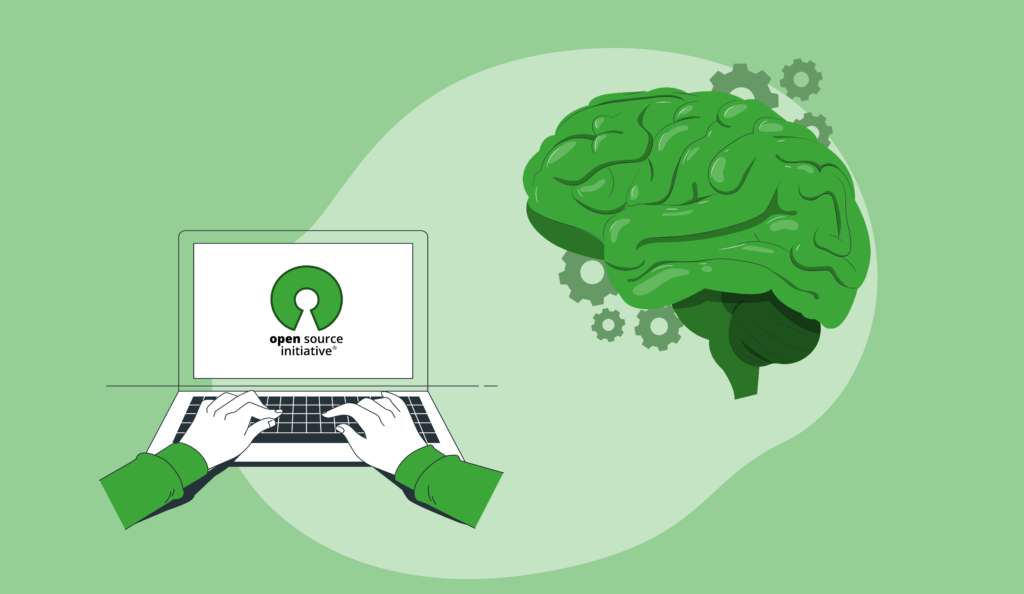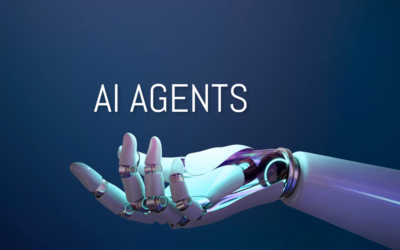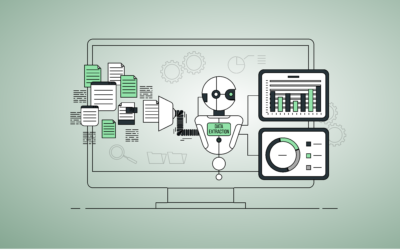Table of Content
Artificial intelligence is evolving at an exponential rate. With so many technologies and tools in the AI market, stakeholders are responsible for building products that will withstand AI’s progress and accumulate value.
Open source drives faster innovation as developers, researchers, and competitors contribute to improving and evolving AI models, tools, and frameworks.
Adopting open-source AI attracts top talent and fosters a culture of innovation within the organization.
Open-source AI allows organizations to design a flexible infrastructure that adapts to advancements, industry changes, regulatory requirements, and market demands.
This paper emphasizes the importance of developing open-source AI applications and provides an overview of essential tools for further discussion.
Embracing Flexibility and Speed in AI Development
Adopting open-source AI technologies reshapes how organizations approach their AI strategies. By engaging with an open ecosystem, businesses access a rapidly expanding selection of services and offerings tailored to diverse use cases.
This flexibility is critical in an era where AI needs vary and continuously evolve.
Customization and Confidentiality
Organizations are increasingly involved in training and fine-tuning to create custom AI models. Different operational requirements necessitate models of varying sizes and complexities. Simple on-device tasks need smaller, more streamlined models, whereas complex analytical tasks demand larger, more sophisticated models.
Open-source AI facilitates this by allowing organizations to take existing models, adapt them with proprietary data, and distill them into optimally sized solutions while maintaining data confidentiality. This is vital for businesses that handle sensitive information or those that prioritize data sovereignty above all.
Avoiding Vendor Lock-in
At Krasamo, we promote open-source AI solutions to future-proof your applications, avoiding vendor lock-in.
Open-source AI reduces dependence on specific vendors for software products and updates. This means organizations are not tied to a single vendor’s costs, limitations, or strategic changes and can switch technologies or customize solutions without contractual constraints.
Many organizations are careful of depending on external models over which they have no control. Concerns include potential changes in model functionality, terms of use, or discontinuation of service. Moreover, the fear of being tethered to a single cloud provider with exclusive model rights is a critical consideration.
Open-source AI circumvents these risks by fostering a broad ecosystem of compatible tools and platforms, offering the freedom to switch providers seamlessly as needs or circumstances change.
Organizations can engage with reputable open-source communities and choose models with strong community support and regular updates.
Cost Efficiency and Security
Open-source AI promises enhanced security through its transparent development process and offers cost-effectiveness. For example, running inference tasks on open-source models can be significantly cheaper than running them on proprietary models like GPT-4. This affordability extends to user-facing and backend operations, whether deployed on-premises or hosted in the cloud.
While open-source AI offers potential advantages in terms of security and cost, it’s essential to weigh these against the risks and hidden costs. The optimal choice depends on specific use cases, security requirements, and available resources.
Long-term Strategic Advantage
The development of open-source AI is not just a tactical move for immediate benefits; it’s a strategic decision for long-term dominance. The open-source community is often at the forefront of AI innovation, moving at a pace that proprietary models struggle to match. Organizations that align with this dynamic and evolving open-source architecture are positioning themselves advantageously for future technological landscapes. Learn more about Generative AI Landscape and Tech Stack.
Understanding Open Source AI Models
An open-source AI model is an artificial intelligence system whose underlying code is publicly available and free to use, modify, and distribute. These models are typically developed and maintained by a community of contributors, including individual developers and organizations.
Open-source AI models are characterized by their transparency. The source code, training algorithms, and architectural details are accessible for scrutiny and enhancement. This openness encourages a collaborative approach to development, fostering innovation and rapid iteration by allowing developers worldwide to contribute improvements and new features.
Open-source AI models have licenses dictating how they can be used, modified, and shared. These licenses are designed to maintain the software’s freedom and ensure enhancements remain available to the community.
The availability of pre-trained models and training procedures as open source enables organizations to adapt AI technologies to their specific needs without the restrictions commonly associated with proprietary systems. This approach democratizes access to cutting-edge technology and enhances security and privacy, as organizations can operate the models on their infrastructure and tailor them to comply with local data protection regulations.
Open-source AI models are available in model hubs, which are repositories for pre-trained models that can be customized to meet specific needs. This accessibility allows researchers and developers to leverage these models for their projects without starting from scratch. Examples of model hubs include Hugging Face Model Hub, TensorFlow Hub, and PyTorch Hub.
Krasamo provides AI development services designed to create adaptable infrastructures, tailor applications, and fine-tune models with proprietary data, ensuring that our AI solutions evolve with client needs.
 |  |  |
| Hugging Face | TensorFlow Hub | Pytorch Hub |
Open-source AI Models
Open-source AI models and tools are developing at a fast pace. We are mentioning just a few of the most popular ones:
Large Language Models (LLMs): A Large Language Model (LLM) is an artificial intelligence model capable of processing and generating human-like text. In AI, a “model” refers to a system trained to make predictions or decisions based on input data. LLMs are specifically designed to understand and produce human language by being trained on massive datasets of text and code.
The Llama Team at AI@Meta developed a family of open models known as Llama, including Llama 3.1, an advanced open-source language model. As part of this family of foundation models, Llama 3.1 is designed to support various AI tasks, including multilingual capabilities, coding proficiency, reasoning, and tool usage.
The flagship model in this series is a dense Transformer with 405 billion parameters and a context window of up to 128,000 tokens. Llama 3.1 models have been extensively evaluated and demonstrate performance comparable to leading language models like GPT-4 across various tasks.
They are particularly noted for their ability to handle complex reasoning and long-context interactions. The models, including pre-trained and post-trained versions, are publicly released under the Llama 3 Community License to drive innovation and research in the AI community.
Gemma is a family of open models developed by Google DeepMind, derived from the Gemini research and technology. These models are characterized by their lightweight, state-of-the-art architecture and are released in two sizes: 2 billion and 7 billion parameters. Gemma models are designed to perform various text-based tasks, excelling in language understanding, reasoning, and safety. They have been rigorously evaluated against various benchmarks and are fine-tuned for enhanced dialogue, instruction-following, helpfulness, and safety capabilities. The models are particularly noted for their strong performance relative to similarly sized open models, making significant advancements in the fields they are trained in.
The DeepSeek open-source family, particularly the DeepSeek-V2.5 model series, is designed for high versatility and competitive performance across various tasks. Key highlights include:
- Language Proficiency: DeepSeek models excel in English and Chinese tasks, achieving strong scores in benchmarks such as MMLU, BBH, and CMMLU. They demonstrate robust reasoning, language understanding, and generative capabilities.
- Coding Expertise: The models are highly capable of coding tasks, as shown in evaluations like HumanEval and LiveCodeBench. They perform well in both static code generation and live coding scenarios.
- Math and Complex Problem Solving: DeepSeek models perform strongly in mathematical benchmarks like GSM8K and MATH, making them suitable for tasks involving logic and computation.
- Innovative Architecture: The models incorporate features like Multi-head Latent Attention (MLA) and DeepSeekMoE, which optimize training efficiency and reduce computational costs during inference.
- Accessibility: With open-source availability and compatibility with Hugging Face’s Transformers library, users can easily integrate and deploy the models locally or via an OpenAI-compatible API.
DeepSeek models are positioned as strong competitors to open-source and proprietary alternatives in the AI space.
Mistral 7B is a cutting-edge open-weight language model developed by Mistral AI. It boasts 7 billion parameters and delivers industry-leading performance across multiple benchmarks. Key highlights of the model include:
- Architecture: It employs advanced techniques such as Grouped-query Attention (GQA) and Sliding Window Attention (SWA) to enhance context understanding and computational efficiency. These optimizations allow it to perform well with short and long-context tasks.
- Performance: Despite its relatively small size, Mistral 7B outperforms larger models like LLaMA 2-13B on several benchmarks. Its design ensures high throughput, making it efficient and powerful for various natural language processing applications.
- Open Access: The model is open-weight, meaning researchers and developers can use it freely for research, commercial, and non-commercial applications. This aligns with the broader mission to make advanced AI capabilities widely accessible.
Use Cases: Mistral 7B is versatile and suitable for tasks including coding assistance, conversational AI, and content generation. It can also be fine-tuned for specialized applications like legal document analysis and personalized conversational agents.
Open Source AI Tools
Kubeflow is an open-source platform designed to make deploying machine learning (ML) workflows on Kubernetes simple, portable, and scalable.
It’s a collection of tools and services that help data scientists and machine learning engineers build and deploy ML pipelines. Key features and benefits of Kubeflow:
- Portability: Run ML workloads on any Kubernetes cluster, whether on-premises or in the cloud.
- Scalability: ML workloads can be easily scaled to meet growing demands.
- Efficiency: Optimize resource utilization and reduce costs.
- Collaboration: Enable teams to work together effectively on ML projects.
- Reproducibility: Ensure consistent and reliable ML experiments.
By providing a unified platform for the entire ML lifecycle, from data preprocessing to model deployment, Kubeflow simplifies the complexities of managing ML workloads in production environments.
TensorFlow is an open-source machine learning framework developed by Google. It provides a comprehensive ecosystem of tools, libraries, and community resources that facilitate the development and deployment of machine-learning models. TensorFlow is known for its flexibility, scalability, and extensive support for deep learning algorithms. It allows developers to build and train various machine learning models, from simple linear regressions to complex deep neural networks, using high-level APIs for ease of use or lower-level APIs for more flexibility and control.
With TensorFlow 2.x, the platform prioritizes eager execution for intuitive development and debugging while retaining the ability to static computational graphs for optimized production workflows. This flexibility enables TensorFlow to accommodate diverse use cases, running efficiently on CPUs, GPUs, and TPUs.
TensorFlow’s open-source nature allows anyone to contribute to its development and benefit from the work of others.
LangChain is an open-source framework designed to help developers build applications using large language models (LLMs). It simplifies the process of creating complex AI applications by providing tools and abstractions for:
- Connecting LLMs to different data sources allows the model to access and process information from various sources, such as databases, APIs, or documents.
- Creating chains of thought: LangChain enables the creation of complex reasoning processes by combining multiple LLMs or other components.
- Improving model performance: By incorporating feedback mechanisms and other techniques, LangChain helps enhance the accuracy and relevance of LLM outputs.
Essentially, LangChain bridges LLMs and real-world data, making building powerful and versatile AI applications easier.
LlamaIndex is a sophisticated data framework designed to enhance the capabilities of Large Language Models (LLMs) like GPT-4. It enables users to integrate their private data, databases, and documents into LLM applications through flexible data connectors. This integration allows for natural language querying and conversation with the indexed data, making LLMs more versatile and applicable to specific organizational needs.
By indexing private data into optimized formats for LLMs, LlamaIndex helps overcome a common limitation of pre-trained models — their general lack of access to specific, contextual information from private sources. The framework uses Retrieval Augmented Generation (RAG) systems to index data during one stage and facilitate querying in another, enhancing the model’s ability to provide accurate and contextually relevant responses.
Semantic Kernel is an open-source AI platform orchestrator that facilitates the integration of AI plugins (or code) with large language models (LLMs). This platform simplifies the interaction with LLMs, vector databases, and prompt templates, making it a powerful tool for businesses leveraging AI to improve efficiency and reduce costs.
Semantic Kernel allows for the creation of specialized tools (functions) to address specific business challenges, making it versatile for various operational and strategic applications. These include natural language understanding, decision-making support, and sophisticated data analysis through semantic functions that interpret meaning derived from data relationships rather than just its raw form.
The platform also supports the rapid development of AI applications from proof of concept to production, providing a robust framework for handling complex computational tasks that require context-aware processing.




















